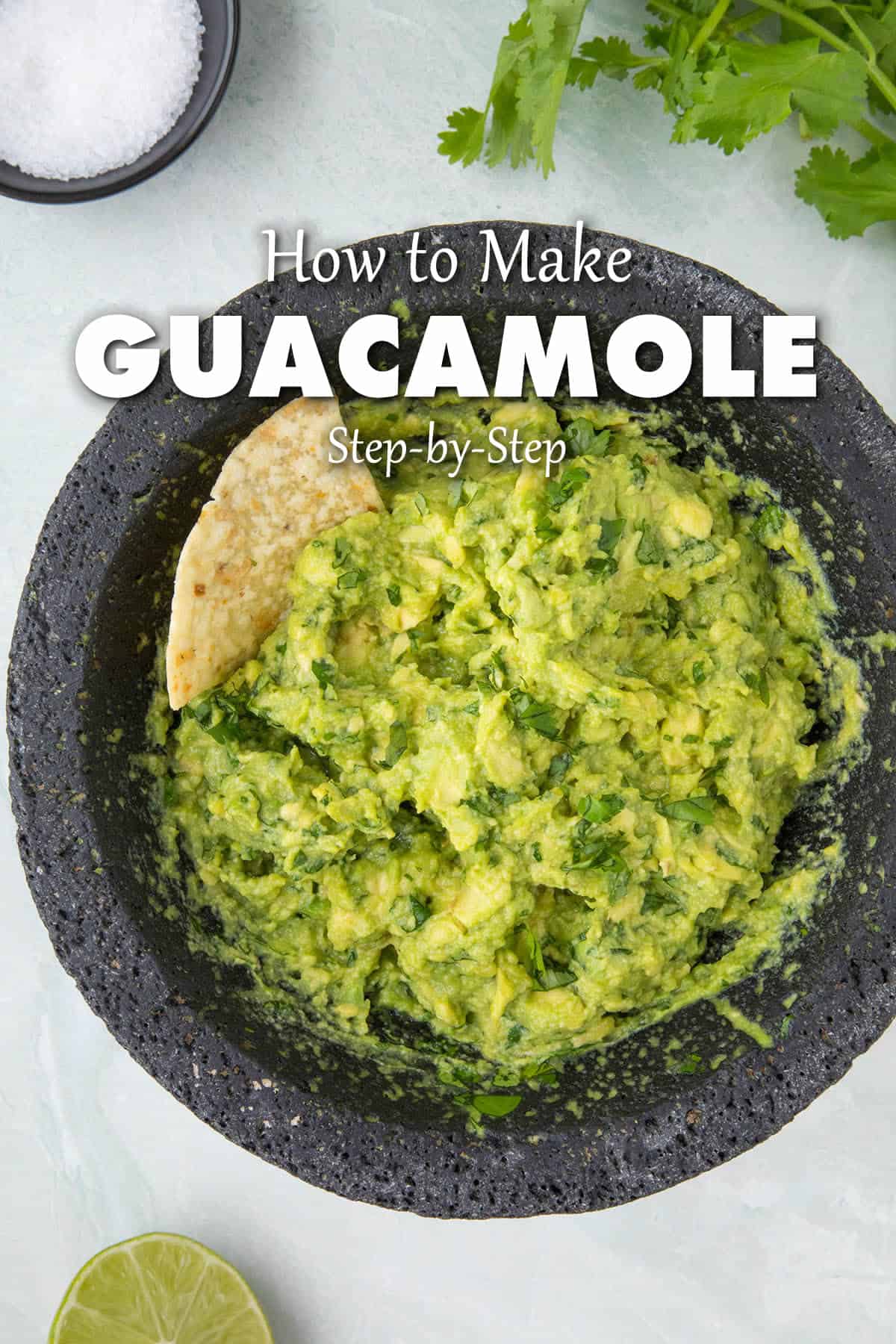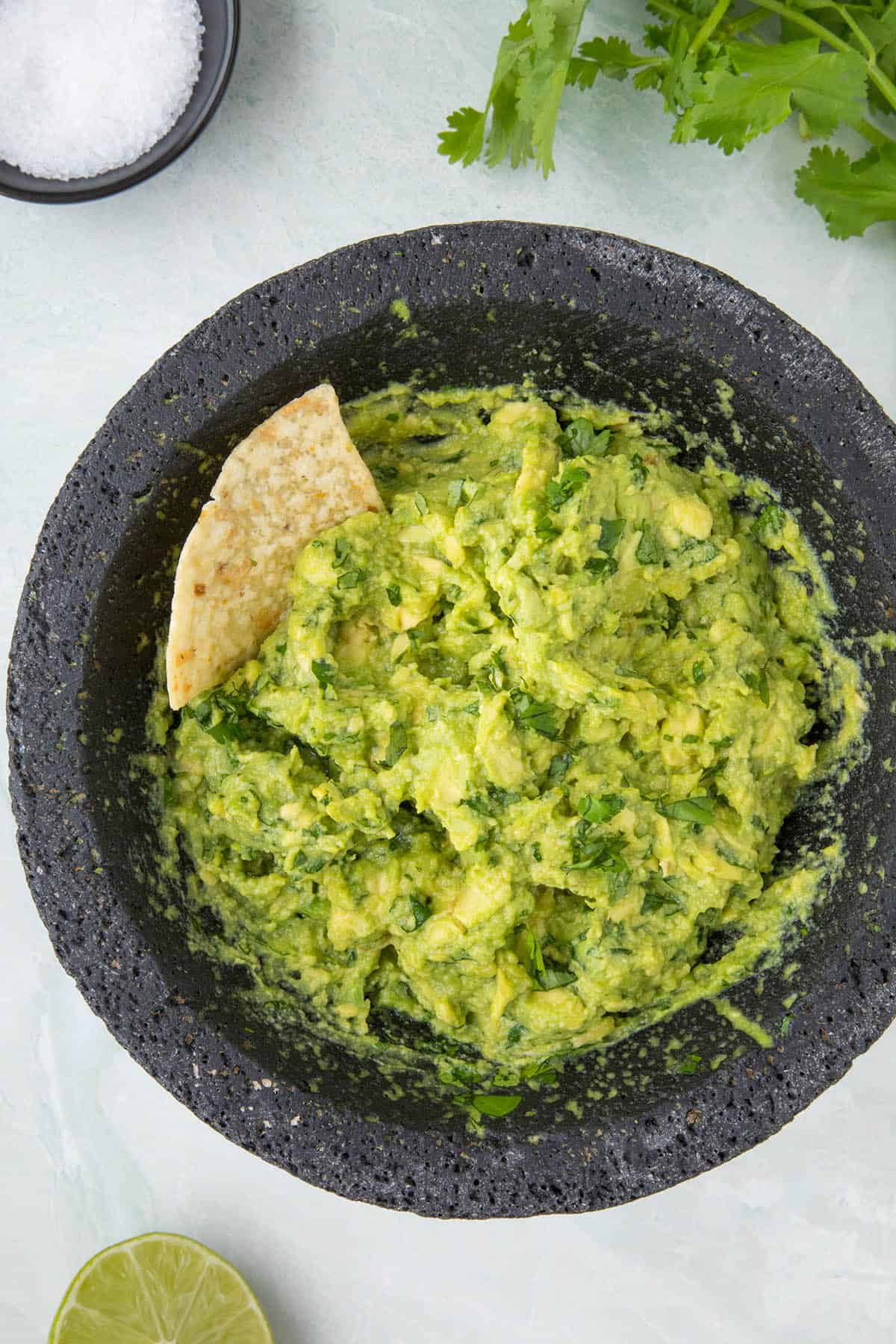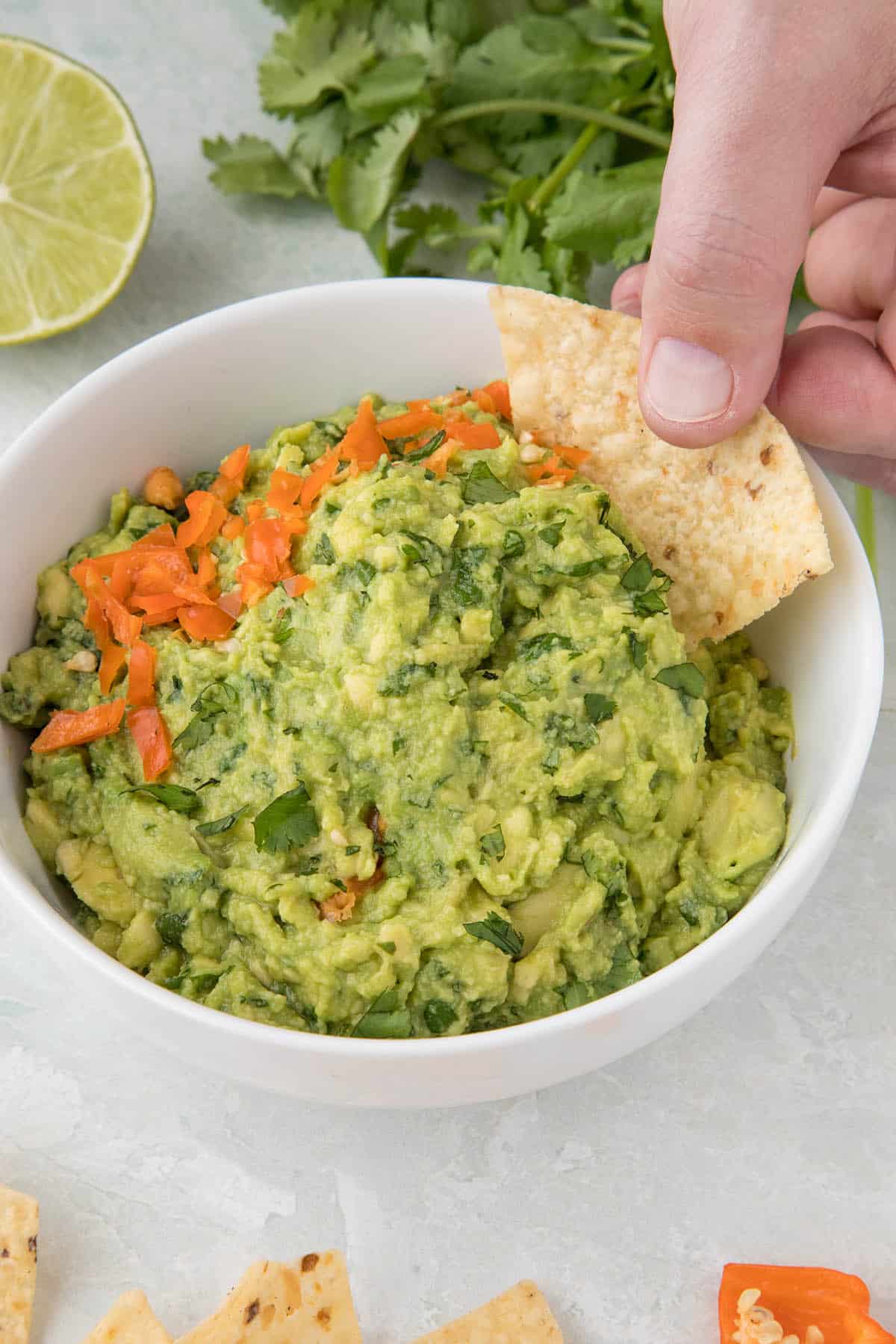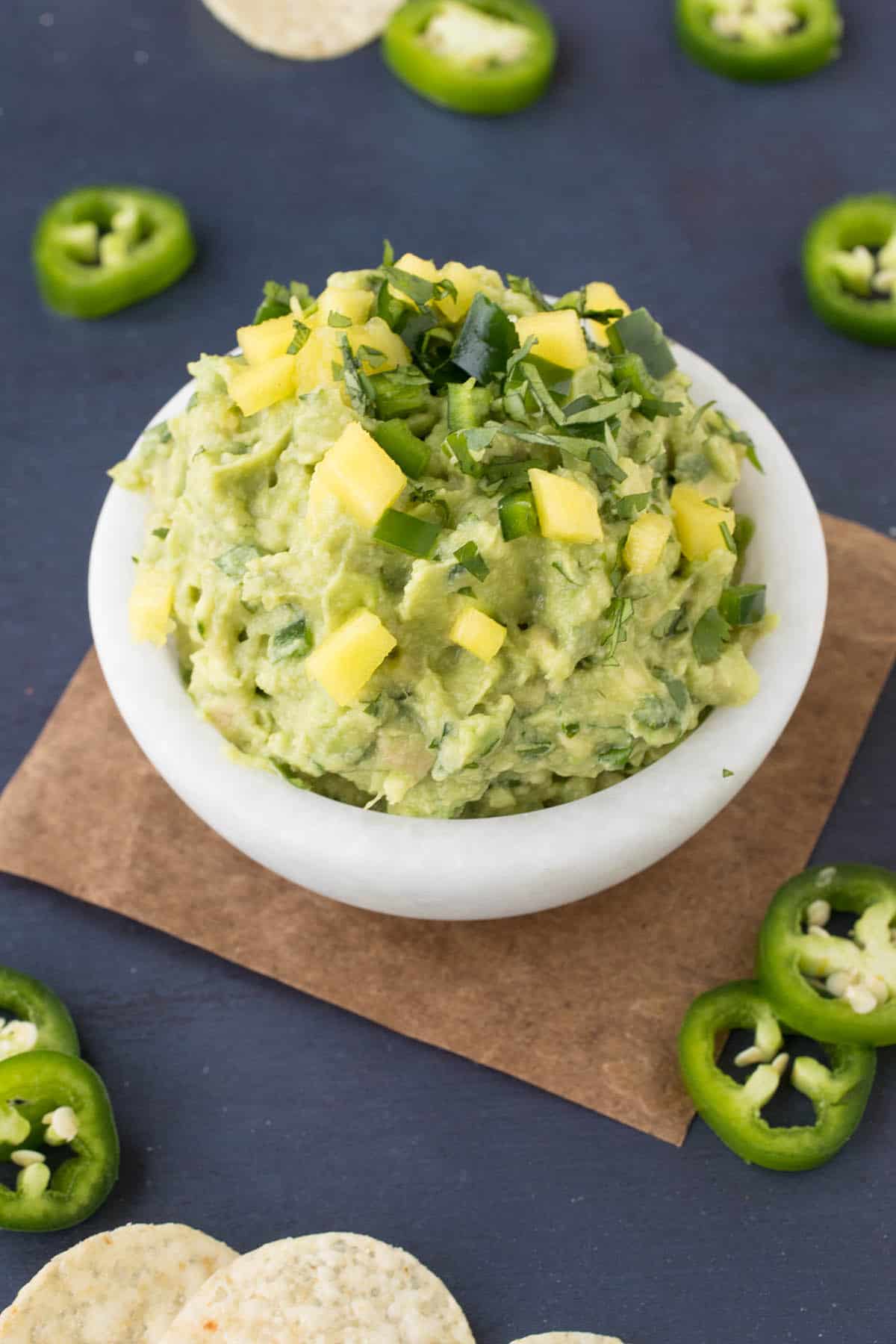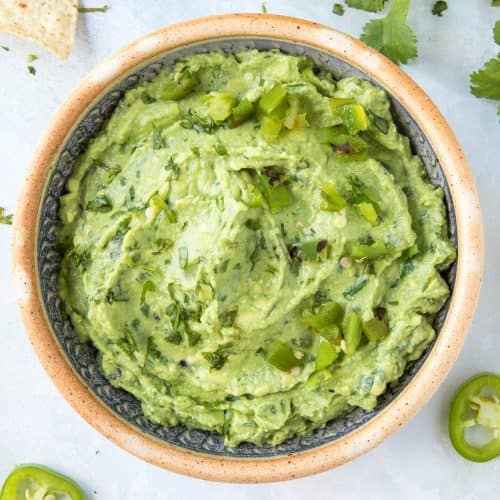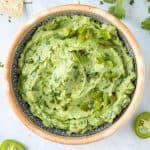If you enjoy this recipe, I hope you’ll leave a comment with some STARS. Also, please share it on social media. Don’t forget to tag us at #ChiliPepperMadness. I’ll be sure to share! Thanks! – Mike H. It is the ultimate appetizer dip, unlike any other. Recipes abound with an incredible variation of ways to prepare this delicacy but just about all guacamole recipes include a variation of some very specific ingredients. If you’re a guacamole lover, but are afraid of trying your hand at a homemade recipe, you might be tempted to run out to the store and purchase a pre-made mix, but put your fears aside. Making homemade guacamole is one of the easiest things to do with the right fresh ingredients. To a mixing bowl, add two peeled and pitted avocados. Add ¼ cup coarsely chopped cilantro, 1 teaspoon fresh lime juice and 2 pinches of salt. Mix thoroughly. The longer you mix the guacamole, the creamier it will be so if you like your guacamole nice and chunky, go easy on the mixing. Give it a taste. What do you think? It’s probably already delicious as it is but now you can adjust your seasonings to taste. Dash of salt here, bit of pepper there. Looking for a bit of a kick? Try adding a chopped or finely diced jalapeno pepper. Keep the jalapeno innards for even greater kick. For an even mightier kick, consider our friend the habanero pepper. Your friends will truly remember your guacamole. Tomato is always a welcomed addition to guacamole for both taste and texture. A finely chopped tomato will add a juicy burst to each bite. The lime juice should be freshly squeezed, not from a bottle, and the cilantro should be firm and cleaned. Freshly picked cilantro is ideal. Use a coarse sea salt for the best results, though most salts will do. Also, I get great results by using my molcajete to mix the guacamole. However, you can mix the ingredients in a large bowl with a fork. It is popular and certainly worth a try but note that sour cream will also dull the heat of any chili pepper additions. Personally, we prefer our guacamole without sour cream. But this is only the beginning of the potential spices you might consider for guacamole variations. Consider taco seasonings, Cajun seasonings, garlic, or other favorite seasonings to make a guacamole recipe all your own.
How to Tell when an Avocado is Ripe
Unripe avocados are definitely not as tasty or guacamole friendly. You really want to use the ripest avocados for your guacamole recipe because they taste richer and are far easier to work with and have a far superior creamier texture. If you try to make a homemade guacamole recipe with unripe avocados, the avocados will not mash properly and you will be left with guacamole that not only has a lumpy texture, but tastes too green. Also unripe avocados are more difficult to peel and remove the pit. The way to tell when an avocado is ripe is by sight and touch. Ripe avocados have a darker green skin. Unripe avocados are typically bright green and darken as they ripen. Also pick up an avocado and squeeze it very slightly to test its firmness. Unripe avocados are very firm to the touch while a ripe avocado is a bit soft and will give way slightly to your fingers. Don’t squeeze to hard as you’ll damage the tender flesh. It’s hard to tell when an avocado is over-ripe but a very over-ripe avocado will be too squishy. The best avocados are the ones that are just slightly softened. It’s best to peel an avocado when it is ripe because it is softer. The first thing you should do is slice off an 1/8 inch off the stem end. Then slice the avocado in half lengthwise all the way around the pit. Give it a twist and pull it apart into two halves. Remove the pit. Be sure the scrape all along the skin and discard any blackened pieces. If you are trying to get the entire half of the avocado for a meal or presentation of some sort, use a spoon and scrape down along the skin and arc the avocado out. If you are looking for the long thin slices, you can easily slice them at this point. Another great way to remove the avocado is to slice a checkerboard pattern into the flesh all the way down to the peel horizontally and vertically. Then either manually invert the skin or scoop with a spoon and the pieces will come out nice and evenly sliced. You can use a spoon to scoop it out but the best way to remove an avocado pit when it is tightly fitted, is to thump it with the dull side of a knife to thwack it loose. Then if it still causes any issues, strike it with the sharp side of the knife and give it a little twist and it should come loose for you. Then scoop out your avocado as needed for your fresh guacamole recipe. Take a small piece of Tupperware or baggie. Squirt in a bit of lemon juice and set the avocado inside with the skin side up. Seal the bag or Tupperware. It helps to add a layer of plastic wrap over the very top and keep it air tight. It should last a few days this way for you. Lemon juice also works for guacamole that has begun to brown. Just squirt a teaspoon or so of lemon juice into your guacamole and stir. The brown should magically disappear and return your guacamole to a delicious bright green state. Here are some alternative guacamole serving suggestions.
Serve your guacamole with sliced pita bread or mini whole wheat pitas Try basic potato chips or other small crunchy dippers like bread sticks, Fritos or pretzels Use guacamole as a topping for chicken or white fish. The guacamole will serve as a makeshift sauce and provide a huge flavor blast. Serve guacamole over burgers as an alternative to plain old catsup and mustard for a southwest style burger. Mix your favorite salsa recipe into your guacamole for an entirely new experience. Try a 50/50 mix of guacamole to salsa or even just a couple of spoonfuls.
1 average sized avocado: 276 calories 50 grams cilantro: 10 calories Lime Juice: 0 calories Salt: 0 calories Tomato: 15 calories (for a whole, average sized tomato) Jalapeno: 4 calories (for an average jalapeno pepper)
As you can see, the vast majority of the calories are in the avocado, so you can adjust accordingly if you are on a calorie restricted diet. This post was updated on 7/16/19 to include new photos and information. It was originally published on 5/1/14.
